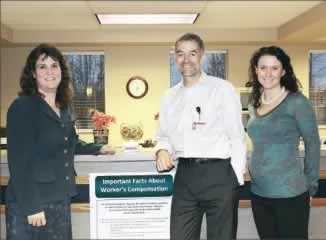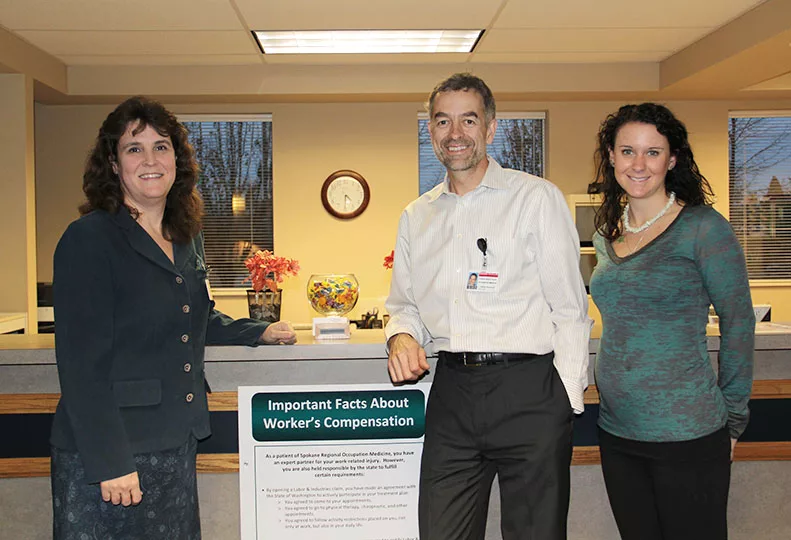Occupational medicine clinic readies for move, rules
Practice aims for bigger niche in commercial driver physicals


Spokane Regional Occupational Medicine, a division of Valley Hospital, is implementing new programs and seeking new certifications so it can continue helping injured workers navigate the claims and recovery process.
Director Debbie Berg says that the practice will be moving its Valley clinic by Jan. 1 to a 3,000-square-foot space in the Medicus Building, at 12615 E. Mission, just north of Valley Hospital.
"In the new office, we'll have more exam rooms and a larger capacity," Berg says, which will allow the clinic to serve more clients.
The 2,200 square-foot clinic currently is located at 1512 N. Vercler, across from Valley Hospital, and the practice has a North Side office, at 605 E. Holland, as well.
The clinic specializes in managing cases of injured workers who need to go through the state Department of Labor & Industries claims process. It also provides drug, hearing, and lung testing, as well as employment physicals and certifications.
Dr. Christopher Goodwin, the clinic's medical director, says the requirements for clinics that provide physicals for those who are looking to be licensed as commercial drivers through the Washington state Department of Transportation are changing, and Spokane Regional Occupational Medicine is looking to keep up with the requirements.
"We anticipate that the Department of Transportation regulations will be more rigid soon," Goodwin says.
WSDOT spokesman Brad Benfield says that by spring 2014, clinics that provide physicals for intrastate commercial drivers will have to be trained and registered with the Federal Motor Carrier Safety Administration's national registry of certified providers. Interstate drivers, meaning those who drive across state lines, are required to pass a physical and keep the resulting medical certification on file with WSDOT, Benfield says. Those who drive just in the state of Washington aren't required to have a medical certification on file.
Goodwin says, and Benfield concurs, that the changing requirements could lead to fewer providers being able to offer the medical certification to patients. However, the occupational medicine practice is committed to maintaining that service, Goodwin says.
"We want to make sure we remain a resource for that for the community," he says.
The clinic also recently has implemented a program to treat needle sticks among health care workers in an effort to prevent the transmission of blood-borne pathogens, such as hepatitis B and C and HIV.
"We get them set up with testing quickly, get them education, and help them update their vaccines," Goodwin says.
One of the clinic's main goals, Goodwin says, is to ensure that injured workers, their employers, and the state all coordinate efficiently to get the patient back to work as fast as is safely possible.
"We make sure the employer is part of the conversation," Goodwin says. "It's different from seeing your doctor at home. There, your information is confidential. But when an injury happens at work, it's between the worker, the employer, and state agencies."
Goodwin says that cooperation between the clinic and area providers is essential to getting workers back on the job. The clinic team coordinates with physical therapists, massage therapists, and chiropractors, among others, both via telephone and in person, he says.
"It really is a team that gets that worker back to work," Goodwin says. "What happens in the first two weeks really determines how quickly the worker will get back."
Goodwin says that injury trends he sees frequently are lower back and shoulder injuries, particularly in health care workers such as home health care, extended care, and hospital workers.
He says that the nature of health care work, especially caring for the elderly and infirm, can put a lot of physical strain on a worker.
Helping patients walk, or get in and out of bed, or perform other transitions can wear on a health care worker. Health care workers also are focused on their patient's needs, not necessarily their own, Goodwin also says.
"Their focus is to try and minimize injury risks," he says.
The clinic, Berg says, sees about 500 to 600 visits a month. That's total visits for the clinic, not individual visits, as one worker's claim may take more than one appointment, she says. The organization has 13 employees across its two locations, Berg says.
Goodwin says that there are many misconceptions about injured workers.
One he has encountered that he feels is inaccurate, Goodwin says, is that injured workers who are receiving money from the state are freeloaders.
"It's really a small minority who are milking the system, those who are getting paid to be injured." he says. "The majority really want to recover; they're often frightened and don't know what's safe for them to do."
Goodwin says an important piece of an injured worker's recovery is making sure they are engaged in improving their health.
"Sometimes they can feel sick when they're really not, from inactivity," he says. "They need to feel like they're still part of the team."
He also says that local and regional L&I offices are crucial in aiding workers throughout recovery.
"I've been very impressed with the general picture here, the claim managers, the L&I staff," Goodwin says.
He adds, "They really want to do their best for workers and employers. A lot of business owners don't like L&I; they think it can bankrupt them. But the people there want to be part of the solution."
Goodwin is also certified by the American Association of Medical Review Officer's board to conduct and review random drug screenings for employers.
Employees can be required to take these screenings in situations such as post-accident and pre-employment scenarios, as well as during random screenings. The clinic both administers the tests and reviews the results, Goodwin says.
Related Articles
Related Products

_c.webp?t=1763626051)
_web.webp?t=1764835652)

